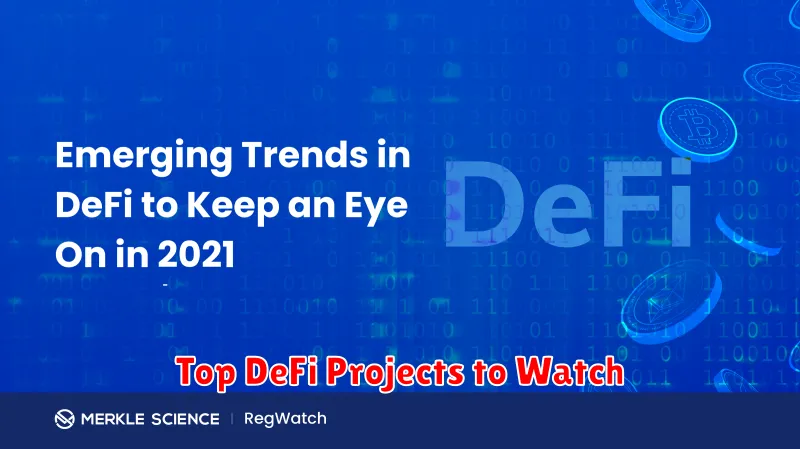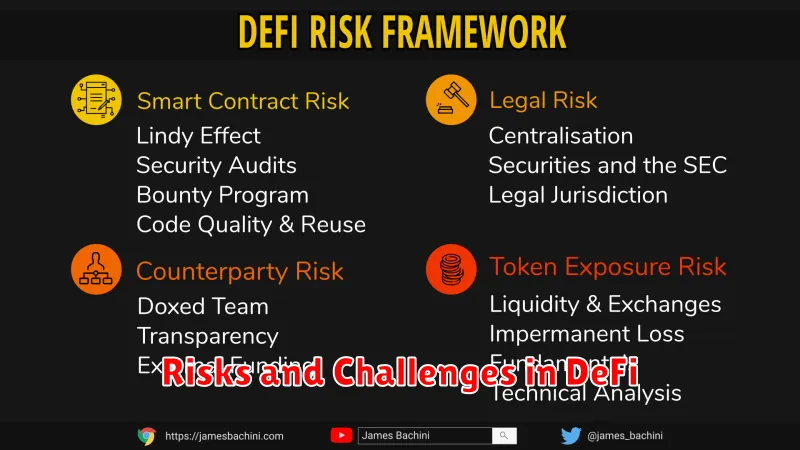Dive into the exciting world of Decentralized Finance (DeFi) and explore its transformative potential in the cryptocurrency landscape! This article delves into the future of DeFi, examining the latest trends, innovative protocols, and emerging technologies shaping this rapidly evolving space. Discover how DeFi is revolutionizing traditional financial systems, offering unprecedented opportunities for crypto investors and paving the way for a more accessible and inclusive financial future. Get ready to uncover the next big thing in the cryptocurrency revolution!
What is Decentralized Finance (DeFi)?
Decentralized Finance, or DeFi, is a rapidly evolving sector within the cryptocurrency ecosystem. It aims to rebuild traditional financial services on a blockchain, eliminating the need for intermediaries like banks and other financial institutions.
Instead of relying on centralized authorities, DeFi leverages smart contracts – self-executing contracts with the terms of the agreement directly written into code – to automate financial transactions. This fosters transparency and security, as all transactions are recorded on a public, immutable ledger.
Key features of DeFi include peer-to-peer lending and borrowing, decentralized exchanges (DEXs), stablecoins, and yield farming. These applications offer users greater control over their assets, potentially higher yields, and increased accessibility to financial services, regardless of their geographic location or credit history.
While DeFi presents many exciting opportunities, it also carries risks. These include smart contract vulnerabilities, security breaches, and the inherent volatility of the cryptocurrency market. Understanding these risks is crucial before participating in the DeFi ecosystem.
The Role of Smart Contracts in DeFi

Smart contracts are the backbone of decentralized finance (DeFi). These self-executing contracts, written in code and stored on a blockchain, automate the execution of agreements. This eliminates the need for intermediaries, a key feature driving DeFi’s decentralized nature.
In DeFi, smart contracts facilitate a wide range of applications. They enable decentralized exchanges (DEXs) to operate without a central authority, allowing users to trade cryptocurrencies directly with each other. They power lending and borrowing platforms, automating the process of collateralization and interest payments. Furthermore, they underpin stablecoins, algorithms that maintain a stable value relative to a fiat currency.
The transparency and immutability of smart contracts are crucial for building trust in DeFi. All transactions are recorded on the blockchain, making them publicly auditable. Once deployed, a smart contract cannot be altered, ensuring the agreement’s terms are enforced as written. However, it’s important to note that security vulnerabilities in smart contract code can be exploited, highlighting the need for rigorous auditing and testing.
Decentralized autonomous organizations (DAOs) also rely heavily on smart contracts. These organizations use smart contracts to govern their operations, manage funds, and make decisions based on pre-defined rules. The ongoing development and improvement of smart contract technology are essential for the continued growth and evolution of the DeFi ecosystem.
Top DeFi Projects to Watch

The Decentralized Finance (DeFi) space is rapidly evolving, with new projects constantly emerging. However, some stand out due to their innovation, community support, and potential for growth. Here are a few top DeFi projects to keep an eye on.
Aave remains a dominant player in the lending and borrowing market, consistently offering competitive interest rates and a diverse range of supported assets. Its robust infrastructure and established user base make it a strong contender for long-term success.
Uniswap, a decentralized exchange (DEX), continues to be a leader in facilitating token swaps. Its automated market-making (AMM) model has proven efficient and user-friendly, making it a cornerstone of the DeFi ecosystem. Ongoing developments and integrations promise continued relevance.
MakerDAO, a pioneering project in the stablecoin space, offers DAI, a stablecoin pegged to the US dollar. Its governance model and sophisticated risk management strategies contribute to its stability and reliability, making it a key player in DeFi’s financial infrastructure.
Compound, another prominent lending protocol, provides a straightforward interface for earning interest on deposited cryptocurrencies and borrowing against collateral. Its focus on transparency and security makes it a dependable choice for users looking for stable returns.
Curve Finance, specializing in stablecoin swaps, offers extremely low slippage and high capital efficiency. Its unique design caters to a niche market within DeFi, making it a valuable component of the broader ecosystem.
It’s important to note that the DeFi landscape is highly volatile. While these projects show strong potential, thorough research and risk assessment are crucial before investing in any DeFi project. The information provided here is for educational purposes and not financial advice.
How DeFi is Disrupting Traditional Finance
Decentralized Finance (DeFi) is rapidly disrupting traditional finance by offering transparent, permissionless, and programmable financial services. Unlike traditional systems reliant on intermediaries like banks, DeFi leverages blockchain technology to create a more efficient and accessible financial ecosystem.
One key disruption is in lending and borrowing. DeFi platforms offer peer-to-peer lending, eliminating the need for intermediaries and potentially offering better interest rates for both lenders and borrowers. Smart contracts automate the process, ensuring transparency and reducing the risk of fraud.
Trading and investing are also being revolutionized. DeFi offers decentralized exchanges (DEXs) that operate without centralized control, providing greater security and potentially lower fees compared to traditional exchanges. Furthermore, DeFi enables access to a wider range of investment opportunities, including exotic assets and derivatives.
Payments are another area experiencing disruption. DeFi facilitates faster, cheaper, and more global transactions, bypassing traditional payment processors and reducing reliance on centralized institutions. This is particularly impactful for cross-border payments where traditional systems often involve high fees and lengthy processing times.
While still in its early stages, DeFi’s potential to reshape the financial landscape is undeniable. By fostering financial inclusion, improving efficiency, and enhancing transparency, DeFi is challenging the established order and paving the way for a more democratized financial future.
Risks and Challenges in DeFi

The decentralized finance (DeFi) space, while offering exciting possibilities, presents several significant risks and challenges. These need careful consideration before engaging with DeFi protocols.
Smart contract vulnerabilities are a major concern. Bugs in the code can be exploited by malicious actors, leading to significant financial losses for users. Audits are crucial but don’t guarantee complete security.
Regulatory uncertainty poses another challenge. The decentralized nature of DeFi makes it difficult for regulators to oversee and control activities, leading to potential legal ramifications for users and projects.
Liquidity risk is inherent in many DeFi protocols. The ability to quickly and easily convert assets into cash can be limited, particularly during periods of market volatility. This can lead to significant losses if users need to exit their positions urgently.
Oracle manipulation can severely impact DeFi applications relying on external data feeds. If the data provided by an oracle is inaccurate or manipulated, it can lead to incorrect calculations and substantial financial losses.
Security breaches and hacks are a constant threat. DeFi protocols are targets for sophisticated attacks aimed at exploiting vulnerabilities and stealing user funds. Rug pulls, where developers abandon a project and take user funds, are another significant risk.
Finally, the complexity of many DeFi protocols can be a barrier to entry for many users. Understanding the mechanics and risks involved requires a high level of technical knowledge and due diligence.
The Growth of DeFi Lending and Borrowing
Decentralized finance (DeFi) lending and borrowing has experienced explosive growth, revolutionizing traditional financial services. This growth is driven by several key factors including accessibility, transparency, and potentially higher yields compared to traditional finance.
Accessibility is a major draw. Unlike traditional banks which often have stringent requirements, DeFi platforms often allow anyone with a crypto wallet to participate, regardless of credit score or location. This opens up financial opportunities for individuals previously excluded from traditional systems.
Transparency is another key advantage. All transactions on the blockchain are publicly auditable, providing a level of transparency unavailable in traditional lending. This enhanced transparency helps build trust and reduces the risk of manipulation.
Higher yields are a significant incentive for lenders. DeFi platforms often offer higher interest rates on deposited assets compared to traditional savings accounts. This increased yield attracts users seeking better returns on their cryptocurrency holdings.
Despite the rapid growth, risks remain. Smart contract vulnerabilities, market volatility, and regulatory uncertainty are significant concerns. Users should carefully research platforms and understand the risks involved before participating in DeFi lending and borrowing.
The future of DeFi lending and borrowing is promising, but challenges remain. As the technology matures and regulation clarifies, we can expect further innovation and wider adoption, potentially reshaping the future of finance.
The Future of Stablecoins in DeFi
Stablecoins, pegged to fiat currencies like the US dollar, are crucial for the growth of Decentralized Finance (DeFi). They bridge the gap between the volatile cryptocurrency market and the stability needed for mainstream adoption. Their future in DeFi hinges on several key factors.
Regulation will play a significant role. Clearer regulatory frameworks are needed to ensure the safety and stability of stablecoins, preventing runs and promoting trust. This includes stricter oversight of reserve management and transparency requirements.
Technological advancements will also shape the future. The development of more robust and efficient stablecoin mechanisms, such as algorithmic stablecoins or decentralized stablecoins backed by diversified assets, could potentially mitigate the risks associated with centralized stablecoins.
Innovation in DeFi applications that utilize stablecoins will continue to drive their demand. Stablecoins are essential for lending, borrowing, yield farming, and other DeFi activities, creating a positive feedback loop of growth and development. The expansion of DeFi into new sectors, such as supply chain finance and insurance, will further increase the demand for stable and reliable stablecoins.
Despite challenges, the future of stablecoins in DeFi remains bright. As the DeFi ecosystem matures and regulations become clearer, stablecoins will likely continue to play a vital role in facilitating mainstream adoption and driving further innovation within the decentralized finance space. The key lies in addressing the risks and vulnerabilities while embracing the potential for increased efficiency and accessibility.
How to Participate in DeFi Safely
The decentralized finance (DeFi) space offers exciting opportunities, but it also presents significant risks. Security should be your top priority. Before investing, thoroughly research any platform or project. Look for audits by reputable firms and check community feedback.
Diversification is key. Don’t put all your eggs in one basket. Spread your investments across multiple protocols and platforms to mitigate losses from a single project failure.
Understand the risks involved. DeFi protocols are often experimental, and smart contracts can contain vulnerabilities. Be prepared for potential losses. Only invest what you can afford to lose.
Use a hardware wallet. This offers significantly greater security compared to storing your crypto on an exchange or in a software wallet. Hardware wallets protect your private keys from hacking and malware.
Stay informed. The DeFi landscape is constantly evolving. Keep up-to-date on the latest news, security updates, and potential vulnerabilities. Follow reputable sources and be wary of scams and misleading information.
Start small. Begin with small investments to gain experience and understand how different DeFi protocols work before committing larger sums of money.
Enable two-factor authentication (2FA) wherever possible. This adds an extra layer of security to your accounts, making it harder for unauthorized individuals to access your funds.
Never share your private keys with anyone. Legitimate platforms will never ask for your private keys. Anyone requesting them is likely attempting to steal your funds.
By following these precautions, you can significantly reduce your risk while exploring the exciting world of DeFi.

